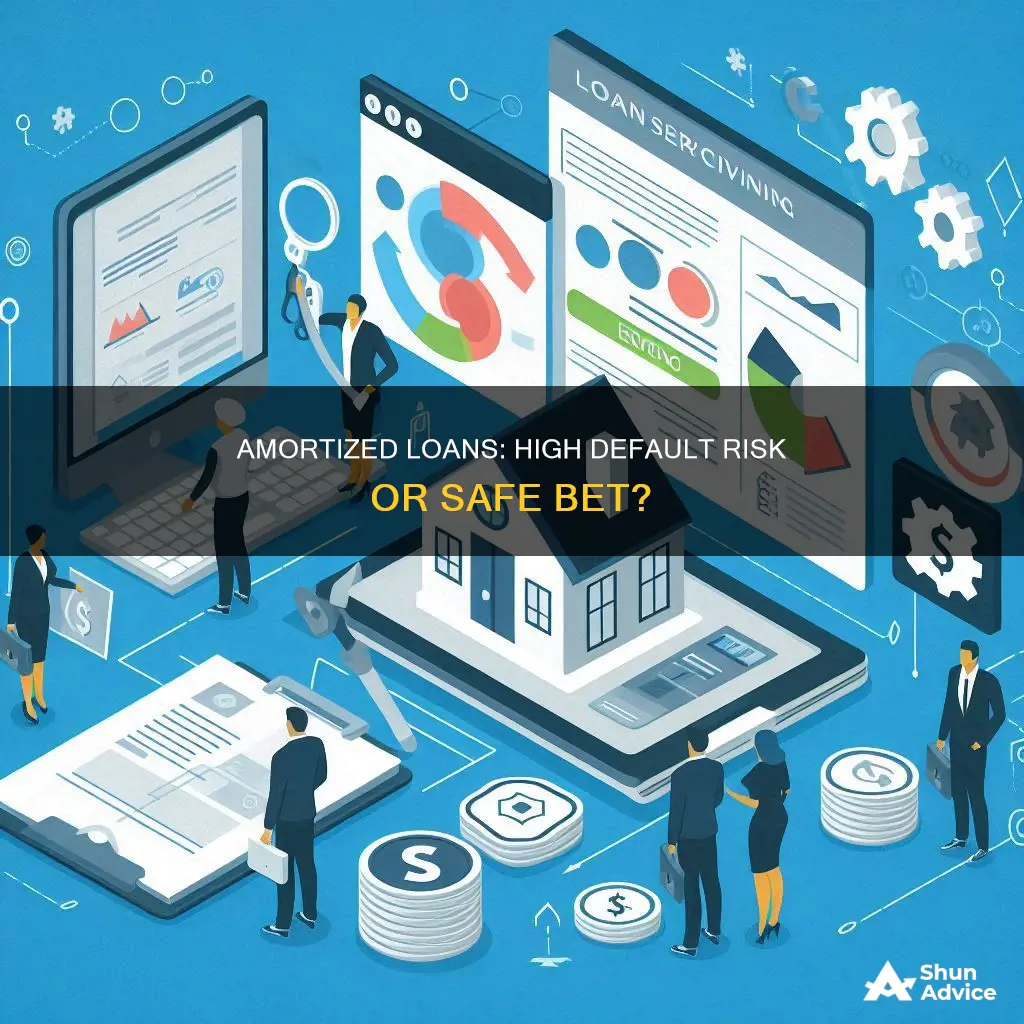
Default risk is the likelihood that a borrower will not be able to make their required payments on a loan. This risk is assessed by lenders and investors through credit reports and credit scores, with a higher default risk resulting in higher interest rates. Amortized loans are a common repayment structure where the loan is paid off through regular, fixed monthly payments over a set period. Fully amortized loans are a type of loan where the borrower pays off the loan balance based on the loan's amortization schedule, ensuring that the loan is fully paid off by the end of the term. Partially amortized loans, on the other hand, may require a large balloon payment at the end of the term, which can be financially challenging for borrowers. This raises the question: do fully amortized loans have a high default risk?
Characteristics and Values of Fully Amortized Loans
| Characteristics | Values |
|---|---|
| Type of Loan | Home loan |
| Repayment Model | Regular monthly payments |
| Interest Rate | Fixed or Adjustable |
| Payment Allocation | Interest and Principal |
| Payment Schedule | Amortization schedule |
| Default Risk | Low |
| Comparison | Low default risk compared to non-amortized loans |
What You'll Learn
- Fully amortized loans have a structured repayment plan with fixed payments
- Amortization schedules show the breakdown of each payment
- The interest rate impacts the amount paid towards the principal
- Non-amortized loans can be risky if cash flow is an issue
- Partially amortized loans are a balance between fully amortized and interest-only loans

Fully amortized loans have a structured repayment plan with fixed payments
Fully amortized loans are a common repayment structure for loans. They are designed so that the borrower pays off their balance based on the loan's amortization schedule. This schedule outlines how much of each payment is applied to interest and principal over the loan's lifetime.
The main advantage of fully amortized loans is the ability to see how your payment is divided up each month. This structured repayment plan with fixed payments makes budgeting easier, as you always know what your payments will be. Each payment covers interest and part of the principal (the amount borrowed). At the beginning of a fully amortized loan, the bulk of your payment will cover interest, with a smaller portion going towards the principal. Over time, this changes so that more of the principal is paid down, and the amount going towards interest decreases.
This type of loan is completely paid off by the end of its term, given that the borrower makes complete payments based on the loan's amortization schedule. This means that, unlike partially amortized loans, there is no large payment at the end of the term, reducing the risk of default.
Fully amortized loans are a common type of loan used today, particularly for fixed-rate, long-term mortgages.
Freddie Mac: Doctor Loan Options and Features
You may want to see also

Amortization schedules show the breakdown of each payment
Amortization schedules are a crucial aspect of fully amortized loans, providing a detailed breakdown of each payment, including the principal and interest components. This transparency enables borrowers to understand their loan repayment journey and make informed financial decisions.
An amortization schedule is a table or chart that serves as a roadmap for borrowers, outlining the specific allocation of each payment towards interest and the reduction of the principal amount. This schedule is particularly important for fixed-rate loans, as it ensures that borrowers pay equal installments throughout the loan term. In the initial years, a larger portion of the payments typically goes towards interest, with the principal receiving a smaller share. However, as the loan progresses, the scales gradually tip, and a greater proportion of the payments chip away at the principal balance.
The amortization schedule is a powerful tool that enables borrowers to forecast their payment obligations and budget effectively. It provides a clear picture of how much will be paid towards interest and principal at various points throughout the loan term. This information is especially valuable for those considering a fully amortized loan, as it allows them to compare different loan offers and make choices that align with their financial goals.
Additionally, the amortization schedule can help borrowers explore strategies to accelerate their loan payoff. For instance, by making extra payments or opting for mortgage recasting, borrowers can reduce their loan balance ahead of schedule and minimize their overall interest costs. This flexibility can be advantageous for those seeking to own their homes outright sooner rather than later.
In summary, amortization schedules are integral to fully amortized loans, offering a transparent breakdown of each payment's composition. This information empowers borrowers to navigate their loan journey confidently, make informed decisions, and even explore options for early repayment. Understanding the amortization schedule is a critical step in the loan process, enabling borrowers to align their financial commitments with their long-term goals.
Freddie Mac Loan Lookup: What You Need to Know
You may want to see also

The interest rate impacts the amount paid towards the principal
The interest rate directly impacts the amount paid towards the principal in a fully amortized loan. This is because the interest and the principal have an inverse relationship within the payments over the life of the loan. At the beginning of a fully amortized loan, the bulk of the payments cover the interest, with only a small portion going towards the principal. As the loan progresses, the scales tip, and the payments increasingly cover the remaining principal balance. This means that the amount paid towards the principal increases over time, while the amount paid towards interest decreases.
The interest rate determines how much of each payment is allocated towards the principal versus the interest. With a fixed-rate mortgage, the interest rate remains constant throughout the loan term, resulting in stable monthly payments. In this case, the combined principal and interest payment remains the same, but the portion allocated to each expense changes monthly. The amount going towards the principal balance increases, while the amount paying off the interest decreases.
On the other hand, with an adjustable-rate mortgage (ARM), the interest rate can change periodically after an initial fixed-rate period. As a result, the amount of principal and interest in each payment can fluctuate. The loan will re-amortize each time the interest rate adjusts to ensure that the loan balance is zero at the end of the term. Therefore, the interest rate directly impacts the allocation of payments towards the principal and interest over the life of the loan.
It is important to note that fully amortized loans are not the only type of loan available. There are also interest-only mortgages, where borrowers make interest-only payments for a set period without reducing the principal. Partially amortized loans are another option, where a set period follows an amortization payment schedule, followed by a large remaining sum due, known as a balloon payment. Understanding these different loan structures is crucial when considering taking out a loan.
Foreclosure Impact: CIBIL Scores and Loan Considerations
You may want to see also

Non-amortized loans can be risky if cash flow is an issue
Non-amortized loans, also known as non-amortizing loans, are loans that do not follow a traditional amortization schedule. Instead of making regular monthly payments that cover both the interest and a portion of the principal, non-amortized loans typically involve interest-only payments or deferred-interest programs. This means that the borrower only pays the interest on the loan during the loan term, and the principal is due as a lump sum at the end of the term.
While non-amortized loans can offer certain benefits, such as lower upfront repayments and increased cash flow due to interest-only payments, they can also carry significant risks, especially if cash flow becomes an issue.
One of the main risks associated with non-amortized loans is the challenge of making the final lump-sum payment. Without a steady reduction in the principal balance over time, as is the case with amortized loans, the borrower is responsible for paying the entire principal amount in one go. This can place a significant strain on cash flow, particularly for businesses or individuals without a stable source of income.
The inability to make the final payment on a non-amortized loan can have severe consequences. In the case of secured loans, where the loan is backed by collateral such as property or a business, the lender may foreclose on the collateral, resulting in the borrower losing their assets. This risk is particularly pertinent for SaaS brands or startups that may have unpredictable cash flow or face difficulties in securing alternative financing options.
Additionally, non-amortized loans often carry higher interest rates than amortized loans because they are usually unsecured and offer lower installment payments. This further increases the cost of borrowing and can exacerbate cash flow issues, especially if the interest rate is variable and increases over time.
Therefore, while non-amortized loans can provide flexibility and potentially lower repayments initially, they can become risky if cash flow becomes a challenge. Borrowers considering non-amortized loans should carefully assess their financial situation, future income prospects, and ability to make the final lump-sum payment to mitigate the risks associated with this type of loan.
How Forbearance Impacts Your Loan: What You Need to Know
You may want to see also

Partially amortized loans are a balance between fully amortized and interest-only loans
The biggest drawback of partially amortized loans is the large repayment due at the end of the contract. This can be financially difficult for some borrowers, increasing the risk of default. However, partially amortized loans can be beneficial for borrowers who need minimal payments while waiting for their cash flow to increase. They can also be attractive to lenders as they do not carry significant duration risk.
Fully amortized loans are the most common type of loan used today. They are a type of loan where borrowers pay off their balance based on the loan's amortization schedule. In a fully amortized loan, every payment is made according to the amortization schedule, which outlines how much of the payment is applied to interest and principal over the loan's lifetime. At the beginning of a fully amortized loan, the bulk of each payment covers interest, with the principal receiving a smaller portion. Over time, this changes, and more of the principal is paid down on the loan.
Interest-only mortgages are a stark contrast to fully amortized loans. With an interest-only mortgage, borrowers only make interest payments for a set period of time. Neither interest-only mortgage structures nor partially amortized loans require borrowers to work on paying down their principal while making interest payments. In contrast, with a fully amortized loan, at least a portion of each payment works to lower the principal balance.
Who Owns My Loan? Freddie Mac and Your Mortgage
You may want to see also
Frequently asked questions
A fully amortized loan is a type of loan where borrowers pay off their balance based on the loan's amortization schedule. The borrower pays off the interest and part of the principal (the amount borrowed) through regular monthly payments.
In a fully amortized loan, the borrower pays off the entire principal and interest by the end of the loan term. In a partially amortized loan, the borrower only pays off the interest during the initial period of the loan, and the principal is paid off in a lump sum at the end of the loan term.
No, fully amortized loans have a lower default risk compared to non-amortized loans. Amortized loans have smaller payments that are spread out over longer periods, making them more manageable for borrowers.







